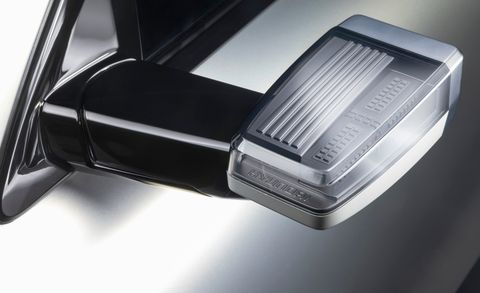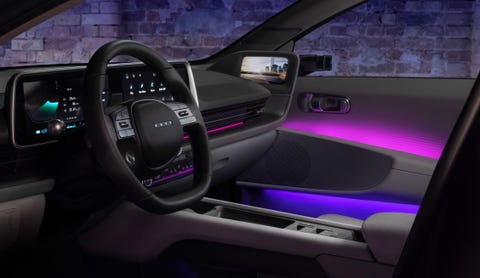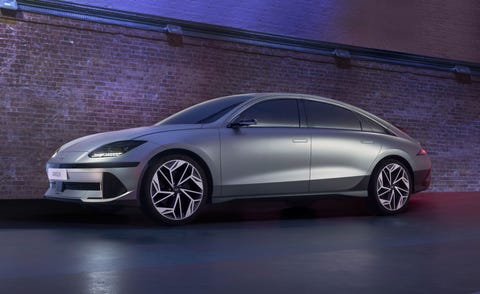2024 Hyundai Ioniq 6, All you want to know & watch about a Great Car
2024 Hyundai Ioniq 6 First Look: A Striking, Swoopy Stake in the Electric Car Ground
One more step in Hyundai’s relentless march toward mainstream EV domination.
Tesla might grab the headlines, but Hyundai Motor Group is the quiet achiever in the race for domination of the EV mass market in America. Thanks to well-built, well-equipped, and well-priced models such as the Hyundai Ioniq 5 and Kona Electric, the Kia EV6 and Niro EV, and the newly launched Genesis GV60, Hyundai Motor Group snared the No. 2 spot in the U.S. electric vehicle market earlier this year, ahead of Ford, Nissan, and Volkswagen.
To be sure, Hyundai Motor Group is still a long, long way behind Tesla in terms of overall EV sales numbers. But there’s no denying the company’s soaring ambition in the segment.
The Hyundai Ioniq 6, which goes on sale here in the first half of 2023, marks one more step in a relentless march that will see Hyundai spend $16 billion on launching more than 30 EV models by 2030 as it targets electric vehicle sales of 3 million vehicles a year.
The company is also spending $5.54 billion on its first dedicated EV factory, to be built near Savannah, Georgia. The factory will be designed to produce up to six EV models for the U.S. market by 2028, including the yet-to-be-seen Hyundai Ioniq 7, a roomy three-row electric SUV that should arrive for 2024, as well a Kia EV pickup reportedly set to go on sale in the first half of 2026.
But first, meet the Ioniq 6.
In simple terms, the Ioniq 6 is the production version of the swoopy Prophecy concept unveiled in 2020. Under the skin is Hyundai Motor Group’s impressive E-GMP EV platform, which underpins both the Hyundai Ioniq 5 and Kia’s EV6 and features the company’s fast-charging 800-volt electrical architecture.
Hyundai Ioniq 6 Power And Battery Capacity
Hyundai hasn’t announced powertrain details yet, but it’s logical to assume the Ioniq 6 will come with the same electric motor and battery pack configurations as the Ioniq 5. That means a rear-drive model with a 225-hp, 258-lb-ft motor powered by a choice of 58-kWh or 77.4-kWh battery packs, plus an AWD model with the bigger battery pack and a 99-hp, 188-lb-ft motor at the front axle to bring the total output to 320 hp and 446 lb-ft.
The Ioniq 6 measures 116.1 inches between the axles, neatly splitting the difference between the Ioniq 5, which has a 118.1-inch wheelbase, and the EV6, which rolls on a 114.1-inch wheelbase. The original plan had been for the Ioniq 6 to share the EV6’s wheelbase, Hyundai Styling Group head Simon Loasby says, but the designers fought hard for the extra inches to improve the car’s proportions.
The wheelbase stretch delivered one other important benefit: more room for rear passengers. Although 5 inches shorter overall than a Honda Accord, the Ioniq 6 boasts almost limousine levels of rear knee- and legroom, though the battery pack means the seat bottom is closer to the flat floor than in a vehicle with an internal combustion engine.
Cool Design Details, Historic Inspiration
One of the original names considered for the Ioniq 6 was Streamliner, Hyundai’s head of global design, SangYup Lee, says. “We decided on Ioniq 6, but I always see a Streamliner badge underneath,” jokes Lee, who referenced images of iconic wind-cheating cars such as the Stout Scarab and Phantom Corsair from the late 1930s and the 1947 Saab 92 during the media preview for the new Hyundai.
“It’s a simple, reductive design,” Lee says of the Ioniq 6’s slippery silhouette, with its low hood, cab-forward stance, and swooping greenhouse. “It’s a pure volume, a proportion you cannot do with an internal combustion engine vehicle.”
And it doesn’t just look like a wind cheater: Every surface of the Ioniq 6 has been honed in the wind tunnel to help deliver a claimed drag coefficient of 0.21, which would make the Ioniq 6 as slippery as a Tesla Model 3.
Cool details abound. The top element of the rear end, which vaguely echoes the form of a vintage Porsche 911’s whale tail spoiler, has a pixel light graphic that rolls over onto its upper surface. The way the rear fenders flow inward toward the upper surface of the trunklid recalls forms found on both old 911s and a Bangle-era BMW 6 Series. Lee’s team tried everything to get rid of the shark-fin antenna on the roof, but when they found they couldn’t for technical reasons, they made it from a dark, translucent material so you can glimpse the electronic hardware within.
But the relentless pursuit of the streamliner ethic has resulted in a couple of awkward design details, like the cutline in the C-pillar, an inevitable byproduct of the need to have a trunklid that extends to the top of the rear fenders. Then there’s the way the rear door cutline extends into roof side rails to allow for the framed door uppers, done to improve rear entry and egress. They’re minor quibbles, and on a dark-colored car, they won’t be noticeable. In person, the Ioniq 6 has a striking presence.
Examining The Ioniq 6’S Interior
The Ioniq 6’s spacious, well-equipped interior has a premium ambience that makes Volkswagen’s ID4 interior look cheap and all the Tesla cabins look spartan. Variable ambient lighting is standard, but the light is bounced off the surfaces of the door panels, so you don’t see the light sources. There’s no Hyundai emblem on the steering wheel, just four pixels that change color: white when voice activation is used and green to show the car is charging.
The digital instrument panel is a 12.0-inch display, with a second 12.0-inch touchscreen for the infotainment system above the center console. As America will get conventional rearview mirrors rather than the cameras available in other markets, there won’t be screens on the wings that flare up at either end of the dash. Two interior trims will be available, both using a variety of sustainable materials, including fabrics from recycled plastics, recycled fishing net carpets, and leather dyed using flaxseed oil.
Hyundai is offering a total of 12 exterior paint colors on the Ioniq 6, including gold and green matte finishes that use bamboo charcoal pigments, though it’s not certain how many of these will make it stateside. Depending on spec, the Ioniq 6 will be fitted with either 18-inch wheels and 225/55 tires or 20-inch wheels with 245/40 tires.
Hyundai sources say the Ioniq 6 will be priced under the smaller Tesla Model 3 when it goes on sale next year, which suggests a starting price of less than $48,000 for the entry-level rear-drive model. Hyundai considers Tesla a luxury brand, and in terms of its pricing and customer perception in the U.S., that’s a fair assumption. But the Ioniq 6, which is a Model 3 and Model S tweener in terms of its overall size with a roomier back seat than either, looks just as upscale as either of Elon’s sedans.
It also looks to be a great value and another head-turning design, both of which are quickly becoming Ioniq brand calling cards.
Angus MacKenzie – Writer / Manufacturer – Photographer / motortrend
2024 Hyundai Ioniq 6 Revealed, Looking Like the Future
The Hyundai Prophecy concept hinted at EV design to come. Do its predictions come to pass in the new Ioniq 6 electric sedan that will start production next year?
- Hyundai has revealed the first photos of the 2024 Ioniq 6, an electric sedan.
- The Ioniq 6 will ride on the same E-GMP platform as the Ioniq 5, Kia EV6, and Genesis GV60.
- Production will start in 2023 for the U.S. market, and the Ioniq 6 will be a 2024 model-year vehicle here.
A few years ago, Hyundai foretold its future: sleek and electric, with design cues pulled from classic and modern inspiration. That was the Prophecy concept, first shown in March 2020. As with all augury, there’s room for interpretation. But our first look at the Ioniq 6, the production car based on the concept, reveals a smooth sedan that clearly references both retro and futuristic influences.
The Ioniq 6 follows the Toyota Prius–like Ioniq and the Ioniq 5, an SUV with 8-bit charm. The Ioniq 6 has a lot to live up to, as both the 5 and the Prophecy concept garnered rave reviews. Both the 5 and the 6 ride on the Hyundai E-GMP dedicated electric platform, shared with the Kia EV6 and the Genesis GV60. The Ioniq 6 rides a little higher than the Prophecy concept, a reality of transferring the vision to a production and street-legal platform.
To give the Ioniq 6 a distinctive look, Hyundai designers say they echoed the streamlined cars of the ’30s. Modern influences seem to be Porsche and Tesla; there’s a faint wisp of Taycan and Model 3 in the front end, and the rear spoiler kicks up like a nod to a ducktail Porsche 911. As promised, it’s a mix of classic and contemporary.
Hyundai design chief SangYup Lee shared his thoughts on the pressures, and rewards, of melding brand personality with brand-new technology.
Lee has penned everything from Chevrolet Camaros and Corvettes to the Bentley Continental GT. He began his design career 27 years after leaving South Korea, following an education at the ArtCenter College of Design in Pasadena, California. Fifteen brands and eight countries later, in 2016, he returned to South Korea to head Hyundai and Genesis design. Along with Luc Donckerwolke, chief creative officer of Genesis and Ioniq, Lee draws novel designs with upscale flair to help Hyundai and Genesis stand out in both the mainstream and luxury markets.
We asked Lee, who’s often overseeing dozens of projects at any given time, how he approaches a Hyundai car as opposed to an upmarket Genesis. Hyundai, he says, views its vehicles like chess pieces. “King, queen, bishop, and knight, they all look different and move differently, but they function as a team,” he says. While a lot of OEMs create a design and then offer it in different sizes like Russian nesting dolls, Lee says Hyundai looks at its customers’ lives: “A big family has different needs than Gen Z.” Lee wants the styling to be distinct, too.
So far, the Ioniq line has achieved the retro-futurist objective it set. The Ioniq 6 feels thoroughly modern and fresh. The interior is uncluttered and elegant. No frilly edges, chrome, or faux chrome. No piano black. Just simple and straightforward. When envisioning the interior, Lee and the team were aware of both the interest in newer tech and the usability of it. “We’re pushing to touchscreens, but they can be dangerous when you’re moving,” he says. “So we want the right balance. In the future, voice activation will play a bigger role, but we’re transitioning right now. If it’s safer, there will be buttons.”
Back-seat passengers benefit from the Ioniq 6’s generous length. The cavernous space has ample legroom for taller adults. This “creates a love-seat atmosphere,” Lee says.
If Hyundai is the mainstream and Genesis the luxury, Ioniq, for now, represents the most daring of the company’s offerings.
2024 Hyundai Ioniq 6, On Youtube
New Hyundai Ioniq 6 – better than a Model S?
New Hyundai IONIQ 6 – detailed first look
IONIQ 6 Design Reveal | Hyundai
NEW Hyundai Ioniq 6: It’s Like NOTHING Else!
For more articles:
——————————————————————————————-
FOLLOW US
Cinema Drama News Turkish Drama Lebanon 4 Seasons Lebanon Magazine The Magazine
Hyundai Ioniq 6 History
The Ioniq 6 was launched on 12 July 2022. It will be produced at the Asan plant in South Korea, which also produces the Sonata and Grandeur,[6] starting in the third quarter of 2022.[7] Pre-orders started in July 2022.[8] Estimated prices are set at ₩55–65 million, which will lower the price of the base model to ₩45 million after federal subsidies are applied in Korea.
Deliveries are scheduled to commence in Korea and selected European markets in late 2022. For the United States market, production is scheduled to start in January 2023 and sales will start in March of that year.[7]
On 14 July 2022, the Ioniq 6 was unveiled at the 2022 Busan International Motor Show in South Korea.[9] EV performance tuning technology, electric vehicle virtual driving sound, and electric vehicle active sound design were applied. The scope of application of OTA software update technology has been extended to suspension, brakes, and airbags. In addition, driving assistance technologies such as navigation-based smart cruise control, highway driving assistance 2, and remote smart parking assistance 2 have been added.[8]
Design development
The Ioniq 6 was previewed by the Prophecy concept car which was showcased in March 2020.[10]
A design sketch was released first as a teaser image on June 21, 2022.[11] The concept sketch of the car represented the “Electrified Streamliner” design approach, built on Hyundai’s new E-GMP platform; the sketch showed a soft streamlined design that minimizes wind resistance. A long wheelbase was applied compared to the overall height.[12]
A series of cropped photos showing details were released in the days leading up to June 29, 2022, when an overall photograph of the Ioniq 6 was unveiled.[13] Hyundai designers described the guiding theme as “Ethical Uniqueness”, embodying a corporate commitment to energy efficiency and environmental responsibility and enabled by the exterior styling theme of “Emotional Efficiency” to satisfy both aesthetic and functional senses.[14] “Parametric pixel” lights and hoods are applied to the front.
In addition, the Ioniq 6 is the first vehicle to use Hyundai’s new stylized-H emblem, which was manufactured in the form of a thin plane made of aluminum. The side profile incorporates a streamlined window line, a built-in flush door handle, and optional side-mounted rear-view cameras in lieu of the conventional side mirrors; attention to these and other aerodynamic details such as rear spoilers, external active air flaps, and wheel air curtains were credited for lowering the coefficient of drag to 0.21.
The rear of the vehicle combines the rear spoiler with parametric pixel auxiliary braking light.[15]
Hyundai Executive Vice President SangYup Lee, who leads the Hyundai Design Center, described the interior as “a mindful cocoon that offers personalized place for all”.[14] The extended interior space is created by the vehicle’s long wheelbase. The vehicle function operation unit was designed to be centralized and the storage space was expanded by applying a bridge-type center console. In addition, eco-friendly materials were applied to interior and exterior painting, sheets, dashboards, and headliners.
RN22e
The RN22e concept is derived from the Ioniq 6 and carries the Hyundai N motorsport sub-brand; it also was revealed in July 2022. The RN22e previews an Ioniq 6 N high-performance variant for regular production;[17] it is equipped with an all-wheel drive powertrain featuring upgraded traction motors that have outputs of 160 and 270 kW (215 and 362 hp) front and rear, respectively, and electronic torque vectoring on the rear differential using a twin-clutch system, branded e-TVTC.
Combined output is 430 kW (577 hp) and 740 N⋅m (546 lbf⋅ft), identical to the drivetrain of the Kia EV6 GT.[20] The motors now rotate at up to 20,000 RPM, compared to 15,000 RPM in the regular Ioniq 6, increasing top speed. Power is supplied by a 77.4 kW-hr battery.[21]
Compared to the regular Ioniq 6, the RN22e is 2.4 in (61 mm) longer and 5.7 in (140 mm) wider, rolling on 21-inch wheels.[20] The cooling system has been upgraded to prevent overheating of the battery and motors.[19] It is equipped with an optional “gearshift mode” which simulates engine noises and a paddle-shifted transmission implemented by briefly decreasing motor output, which was called “surprisingly convincing” but slowed the car’s overall lap time.[21]
The RN22e is being used to test components that will be fitted to the racing variant of the Ioniq 6, with which Hyundai N plan to campaign in the eTouring Car World Cup series starting in 2023. The forthcoming Ioniq 6-based racing car will replace the Veloster N ETCR that was raced in 2021 and 2022.[21] During a hands-on session at the Bilster Berg track, Motor Trend writer Angus MacKenzie noted “the RN22e was setup deliberately to be something of a show-off drift king, to prove an EV can make you smile behind the wheel”.












